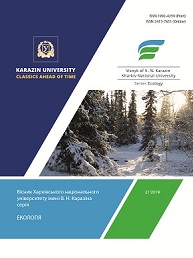Zmiinyi Island Coastal Zone Macrozoobenthos State in 2016-2017
Abstract
Purpose. To study the state of macrozoobenthos in the Zmiinyi Island coastal zone in 2016-2017.
Methods. Standard methods of macrozoobenthos sampling, determination, number and biomass estimation.
Results. Results of analysis of biodiversity, structural characteristics and taxonomic composition of macrozoobenthos in the Zmiinyi Island coastal zone have been presented. Seasonal dynamics of its number and biomass has been studied. Assessment of marine environment quality has been performed based on the metrics of macrozoobenthos.
Conclusions. Altogether, 132 taxa of benthic invertebrates belonging to 10 biggest taxonomic groups of macrozoobenthos have been identified in the Zmiinyi Island coastal zone in 2016-2017. Analysis of taxonomic composition identified 1 species of Porifera (0.8%), 7 taxa of Cnidaria (5.3%), 3 taxa of Platyhelminthes (2.3%), 1 taxon of Nemertea (0.8%), 3 taxa of Bryzoa (2.3%), 52 taxa of Annelida (39.4%), 25 taxa of Mollusca (18.9%), 35 taxa of Arthropoda (265%), 2 taxa of Echinodermata (1.4%) and 3 taxa of Chordata (2.3%). Out of 132 macrozoobenthos taxa 6 are enlisted in the Red Data Book of Ukraine and 8 – in the Black Sea Red Data Book. Macrozoobenthos number varied from 0.317х104 (27.11.2016) to 16.943х104 (19.08.2016) ind/m2 on soft substrate and from 2.683х104 (17.05.2016) to 30.725х104 (19.08.2016) ind/m2 on rocky substrate; biomass varied from 0.017 (17.05.2017) to 34.857 (19.08.2016) kg/m2 on soft substrate and from 1.531 (27.11.2016) to 46.147 (19.08.2016) kg/m2 on rocky substrate. Maximal development of benthos was registered in summer period. Quality of marine environment on the AMBI and M-AMBI indices was assessed as Good in 21 cases out of 23 and as Moderate in 2 cases 2 out of 23. Mean values of AMBI and M-AMBI indices for different seasons made respectively: May, 2016 – 2.56 and 0.59; August, 2016 – 1.86 and 0.69; November, 2016 – 1.70 and 0.71; June, 2017 – 1.87 and 0.75.
Downloads
References
Bushuev, S. G., Kurakin, A. G., Chichkin, V. N. (2004). Assessment of stock of commertial invertebranes (rapa vhelk, mussels) in the Zmiinyi Island coastal zone. Ecological Problems of the Black Sea: 6th Symposium, 11 – 12 October, 2004. Odessa: OTsNTEI. 80-84. (In Russian).
Vinogradov, K. A. (1958). Sketch-book on the history of hydrobiological studies of the Black Sea. Kiev: Pub-lisher of the Academy of Sciences of the YkrSSR. (In Russian).
Zaitsev, Yu. P., Aleksandrov, B. G., Minicheva, G. G. et al. (2006) North-Western Black Sea: hydrology and ecology. Kiev: Naukova Dumka. 701. (In Russian).
Medinets, V. I., Chichkin, V. M., Snigirev, S. M. (2008). Zmiinyi Island: Ecosystem of coastal waters : monograph. Odessa, Astroprynt. (In Ukrainian).
Zhdanov, L. P. (Ed.). Methodological guidelines No.36. (1971). Leningrd : Gidrometeoizdat. (In Russian).
Mordukhay-Boltovsky F. D. (Ed.). (1972). Identification guide of the Azov and Black Seas fauna. Kiev. Nauko-va Dumkaа, 1-3. (In Russian).
Tsyban A. V. (Ed.). (1980). Manual on methods of biological analysis of sea water and sediments. Leningrad: Gidrometeoizdat. (In Russian).
Sinegub, I. A. (2001). Macrozoobenthos of the Zmiinyi Island (Black Sea) coastal waters. In : Environmental safety of the coastal and shelf zones and integrated management of shelf resources (pp. 301-315). NASU, MHI, OB IBSS. Sevastopol. (In Russian).
Snigirev, S. M., Chernyavskiy, A. V., Naum, E. A., Galkina, A. A., Medinets, V. I., Gazyetov, Ye. I., Konareva, O. P., Snigirev, P. M. (2019). State of macrozoobenthos in Odessa Bay coastal waters in 2016-2017. Man and environment. Issues of neoecology, (31), 40-56. (In Russian).
Akimov, I. A. (Ed.). (2009). Red Data Book of Ukraine. Fauna. Kyiv: Globalkonsalting. (In Ukrainian).
Chichkin, V. N., Kurakin, A. P. (2005). Mussels of the Zmiinyi Island. Proceedings of Ternopol National Peda-gogical University. Series: Biology. Special edition “Hydroecology”, 4 (27), 264-266. (In Russian).
Dumont, H. J. (Ed.). (1999). Black Sea Red Data Book. New York: United Nations Office for Project Services.
Borja, A., (2006). The new European Marine Strategy Directive: Difficulties, opportunities, and challenges. Marine Pollution Bulletin, 52, 239-242.
Borja, Á., Galparsoro, I., Irigoien, X., Iriondo, A., Menchaca, I., Muxika, I., Pascual, M., Quincoces, I., Revilla, M., Germán Rodríguez, J., Santurtún, M., Solaun, O., Uriarte, A., Valencia, V., Zorita, I. (2011). Implementation of the European Marine Strategy Framework Directive: A methodological approach for the assessment of environmental status, from the Basque Country (Bay of Biscay). Marine Pollution Bulletin, 62, 889-904.
Poppe, G.T. and Goto, Y. (1991). European seashells. Polyplacophora, Caudofoveata, Solenogastra, Gas-tropoda. 1. Wiesbaden: Hemmen.
Snigirov, S., Medinets, V., Chichkin, V., Sylantyev, S. (2013). Rapa whelk controls demersal community struc-ture off Zmiinyi Island, Black Sea. Aquatic Invasions, 8 (3), 289-297.
Todorova, V., Prodanov, B., Dimitrov, L., Kotsev, I. (2013) Initial Assessment of the marine environmental status according to art. 8 of the Regulation for marine environmental protection. Retrieved from https://www.academia.edu/10234304/INITIAL_ASSESSMENT_OF_THE_TECHNOGENIC_PRESSURE_IN_THE_MEDIOLITTORAL_ZONE_OF_THE_BULGARIAN_BLACK_SEA_COAST
Todorova, V. and Konsulova, T. (2005). Manual for quantitative sampling and sample treatment of marine-soft bottom macrozzobenthos.
World Register of Marine Species (WoRMS). (2019). Retrieved from http://www.marinespecies.org/
Authors who publish with this journal agree to the following terms:
- Authors retain copyright and grant the journal right of first publication of this work under the terms of a license Creative Commons Attribution License 4.0 International (CC BY 4.0).
- Authors are able to enter into separate, additional contractual arrangements for the non-exclusive distribution of the journal's published version of the work (e.g., post it to an institutional repository or publish it in a book), with an acknowledgement of its initial publication in this journal.
- Authors are permitted and encouraged to post their work online (e.g., in institutional repositories or on their website) prior to and during the submission process, as it can lead to productive exchanges, as well as earlier and greater citation of published work.





